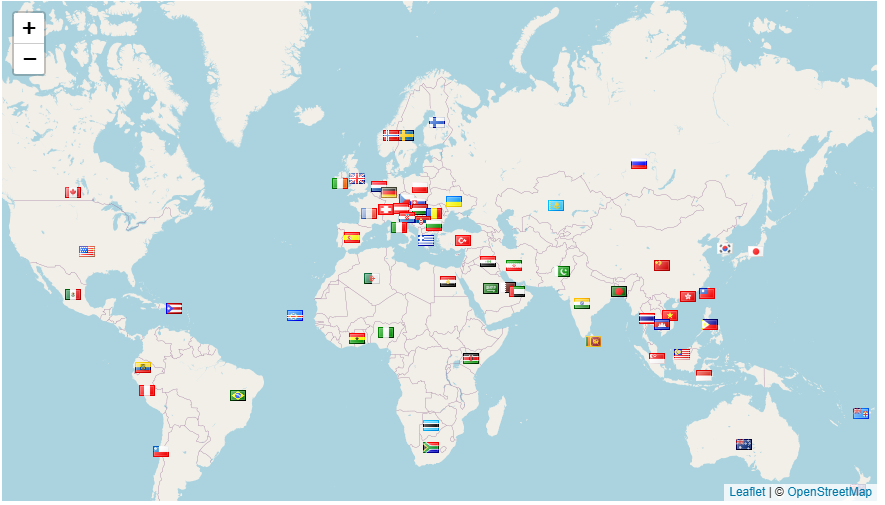Response of Vibration Reduction with Additional of Dual Dynamic Vibration to The Main System
DOI:
https://doi.org/10.70822/journalofevrmata.vi.4Keywords:
DDVA, vibration, rotational vibration, translational vibrationAbstract
Excessive vibration in a system occurs when the force acting on a system is close to the natural frequency of the system. This vibration can be reduced by adding a dynamic vibration absorber (DVA) to the system. Several researchers have done a lot of research related to DVA and dual DVA (DDVA) placement in the main system. In this research, we conducted a study of the effect of DDVA-dependent addition on translational and rotational vibration responses in the 2-dof main system. This research was started by building a prototype of a 2 DOF vibration system without DDVA and with DDVA. From the prototype, equations of motion and block simulations were then made to determine changes in vibration characteristics that occur in the main system. From the research results it was found that the placement of the DDVA-dependent cantilever absorber at the end of the system with rI 1/10 was able to reduce the vibration of the main system with a percentage reduction at a frequency of 12.78 Hz of 94.1681% for the translation direction and 15.3878% for the rotation direction. Changes in the distance ratio and the inertia ratio of the absorber mass do not affect the DDVA-dependent ability to reduce vibrations in the translation direction.
References
G. Park, D. You, K. Y. Oh, and W. Nam, “Natural Frequency Degradation Prediction for Offshore Wind Turbine Structures,” Machines, vol. 10, no. 5, 2022, doi: 10.3390/machines10050356.
Y. S. You, K. Y. Song, and M. Y. Sun, “Variable Natural Frequency Damper for Minimizing Response of Offshore Wind Turbine: Principle Verification through Analysis of Controllable Natural Frequencies,” J. Mar. Sci. Eng., vol. 10, no. 7, 2022, doi: 10.3390/jmse10070983.
T. You, J. Zhou, D. J. Thompson, D. Gong, J. Chen, and Y. Sun, “Vibration reduction of a high-speed train floor using multiple dynamic vibration absorbers,” Veh. Syst. Dyn., vol. 60, no. 9, 2022, doi: 10.1080/00423114.2021.1928248.
Y. Hua, W. Wong, and L. Cheng, “Optimal design of a beam-based dynamic vibration absorber using fixed-points theory,” J. Sound Vib., vol. 421, pp. 111–131, 2018, doi: https://doi.org/10.1016/j.jsv.2018.01.058.
Susastro, I. S. Atmanto, and S. U. Handayani, “Vibration Response Characteristics of 2 DOF Systems with the Addition of Dual Translational Dynamic Vibration Absorber by the Experimental Approach,” Int. J. Mech. Eng. Technol., vol. 10, no. 12, pp. 1–9, 2019.
M. H. Mustaffer, R. Ramlan, M. N. Abdul Rahman, and A. Putra, “Experimental characterization and performance of dynamic vibration absorber with tunable piecewise-linear stiffness,” J. Brazilian Soc. Mech. Sci. Eng., vol. 42, no. 7, 2020, doi: 10.1007/s40430-020-02435-x.
K. S. Mohamed, F. Amri, M. Elboraey, N. H. D. Nordin, and A. G. A. Muthalif, “Adaptive Electromagnetic Vibration Absorber for a Multimode Structure,” Stroj. Vestnik/Journal Mech. Eng., vol. 68, no. 3, 2022, doi: 10.5545/sv-jme.2021.7458.
Q. Wang, H. Qiao, D. De Domenico, Z. Zhu, and Y. Tang, “Seismic performance of optimal Multi-Tuned Liquid Column Damper-Inerter (MTLCDI) applied to adjacent high-rise buildings,” Soil Dyn. Earthq. Eng., vol. 143, 2021, doi: 10.1016/j.soildyn.2021.106653.
H. Gazi and C. Alhan, “Reliability of elastomeric-isolated buildings under historical earthquakes with/without forward-directivity effects,” Eng. Struct., vol. 195, 2019, doi: 10.1016/j.engstruct.2019.05.081.
H. Li, Y. Yu, J. Li, Y. Li, and M. Askari, “Multi-objective optimisation for improving the seismic protection performance of a multi-storey adaptive negative stiffness system based on modified NSGA-II with DCD,” J. Build. Eng., vol. 43, 2021, doi: 10.1016/j.jobe.2021.103145.
C. Cruz and E. Miranda, “Evaluation of soil-structure interaction effects on the damping ratios of buildings subjected to earthquakes,” Soil Dyn. Earthq. Eng., vol. 100, 2017, doi: 10.1016/j.soildyn.2017.05.034.
J. S. Love and B. Morava, “Practical Experience with Full-scale Performance Verification of Dynamic Vibration Absorbers Installed in Tall Buildings,” Int. J. High-Rise Build., vol. 10, no. 2, 2021, doi: 10.21022/IJHRB.2021.10.2.85.
C. Huang and J. Zeng, “Suppression of the flexible carbody resonance due to bogie instability by using a DVA suspended on the bogie frame,” Veh. Syst. Dyn., vol. 60, no. 9, 2022, doi: 10.1080/00423114.2021.1930071.
T. Konar and A. D. Ghosh, “Adaptive Design of an Overhead Water Tank as Dynamic Vibration Absorber for Buildings by Use of a Stiffness-Varying Support Arrangement,” J. Vib. Eng. Technol., 2022, doi: 10.1007/s42417-022-00611-y.
Y. R. Wang and H. G. Lu, “Damping performance of dynamic vibration absorber in nonlinear simple beam with 1:3 internal resonance,” in International Journal of Acoustics and Vibrations, 2017, vol. 22, no. 2. doi: 10.20855/ijav.2017.22.2462.
J. Grosel and M. Podworna, “Optimisation of absorber parameters in the case of stochastic vibrations in a bridge with a deck platform for servicing pipelines,” Stud. Geotech. Mech., vol. 43, no. s1, 2021, doi: 10.2478/sgem-2021-0030.
H. Saber, F. S. Samani, and F. Pellicano, “A novel nonlinear variable damping device and its application for the systems with uncertain parameters,” Proc. Inst. Mech. Eng. Part K J. Multi-body Dyn., vol. 236, no. 4, 2022, doi: 10.1177/14644193221115007.
P. Li, W. Zhai, Z. He, and G. Shi, “A study on vibration suppression of a bridge in Sichuan-Tibet Railway and running safety of a train under floating ice collision,” Zhendong yu Chongji/Journal Vib. Shock, vol. 41, no. 8, 2022, doi: 10.13465/j.cnki.jvs.2022.08.008.
J. S. Love and Z. J. Taylor, “A method to generate dynamic vibration absorber load combinations,” J. Wind Eng. Ind. Aerodyn., vol. 194, 2019, doi: 10.1016/j.jweia.2019.103977.
N. R. Karnopp and H. M. Gomes, “Hybrid active vibration control in wind turbine towers,” in World Congress in Computational Mechanics and ECCOMAS Congress, 2021, vol. 900. doi: 10.23967/wccm-eccomas.2020.171.
K. A. Kapasakalis, I. A. Antoniadis, E. J. Sapountzakis, and A. E. Kampitsis, “Vibration Mitigation of Wind Turbine Towers Using Negative Stiffness Absorbers,” J. Civ. Eng. Constr., vol. 10, no. 3, 2021, doi: 10.32732/jcec.2021.10.3.123.
C. L. Chin, J. T. Lee, and G. P. Mathur, “Analytical modeling of active/passive smart foam noise control treatment in aerospace vehicles,” in 8th AIAA/CEAS Aeroacoustics Conference and Exhibit, 2002. doi: 10.2514/6.2002-2414.
J. Song, P. Si, H. Hua, and Z. Li, “A DVA-Beam Element for Dynamic Simulation of DVA-Beam System: Modeling, Validation and Application,” Symmetry (Basel)., vol. 14, no. 8, 2022, doi: 10.3390/sym14081608.
M. Karimi, M. Shemshadi, and N. Firoozfam, “A simple method to design and analyze dynamic vibration absorber using dimensional analysis,” JVC/Journal Vib. Control, vol. 27, no. 1–2, 2021, doi: 10.1177/1077546320923928.
S. Il Ha and G. H. Yoon, “Numerical and Experimental Studies of Pendulum Dynamic Vibration Absorber for Structural Vibration,” J. Vib. Acoust. Trans. ASME, vol. 143, no. 1, 2021, doi: 10.1115/1.4046951.
P. Gao, H. Liu, P. Yan, and C. Xiang, “Optimization of the frequency tracking scheme for an adaptively tuned vibration absorber,” J. Sound Vib., vol. 512, 2021, doi: 10.1016/j.jsv.2021.116376.
J. hai Wu, H. zhen Zhu, Y. dong Sun, Z. yong Yin, and M. zhu Su, “Reduction of flexural vibration of a fluid-filled pipe with attached vibration absorbers,” Int. J. Press. Vessel. Pip., vol. 194, 2021, doi: 10.1016/j.ijpvp.2021.104525.
A. K. Chopra, Dynamics of structures : theory and applications to earthquake engineering. Englewood Cliffs, N.J. SE -: Prentice Hall, 1995. doi: LK - https://worldcat.org/title/31738515.
S. G. Kelly, Mechanical vibrations : theory and applications. Stamford, CT SE -: Cengage Learning, 2012. doi: LK - https://worldcat.org/title/654314471.
H. Qi, Y. Wen, and Z. Ji, “Vibration Reduction Method of Multiple Dynamic Vibration Absorbers Considering Vehicle Body Elasticity,” Zhendong Ceshi Yu Zhenduan/Journal Vib. Meas. Diagnosis, vol. 41, no. 6, 2021, doi: 10.16450/j.cnki.issn.1004-6801.2021.06.017.
G. Gatti, A. D. Shaw, P. J. P. Gonçalves, and M. J. Brennan, “On the detailed design of a quasi-zero stiffness device to assist in the realisation of a translational Lanchester damper,” Mech. Syst. Signal Process., vol. 164, 2022, doi: 10.1016/j.ymssp.2021.108258.
E. Barredo, J. G. Mendoza Larios, J. Mayén, A. A. Flores-Hernández, J. Colín, and M. Arias Montiel, “Optimal design for high-performance passive dynamic vibration absorbers under random vibration,” Eng. Struct., vol. 195, 2019, doi: 10.1016/j.engstruct.2019.05.105.
A. Rohman, K. Muzaka, and C. Anam, “Optimization of Excitation Source and Dva Mass from the Weight Point in the 2-Dof Main Systems in Reducing Translation and Rotation Vibration,” in IOP Conference Series: Materials Science and Engineering, 2019, vol. 494, no. 1. doi: 10.1088/1757-899X/494/1/012039.
Downloads
Published
Issue
Section
License
Copyright (c) 2023 Talifatim Machfuroh, Zakiyah Amalia, Fica Aida

This work is licensed under a Creative Commons Attribution 4.0 International License.







